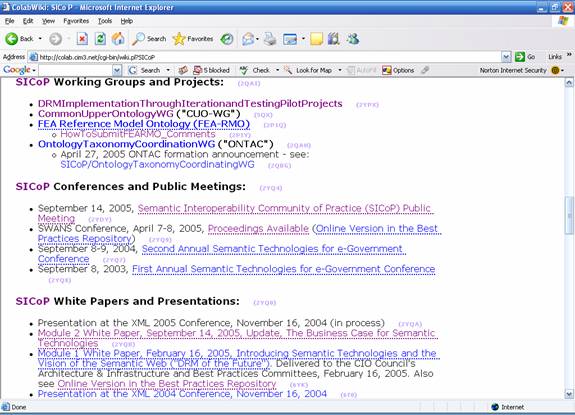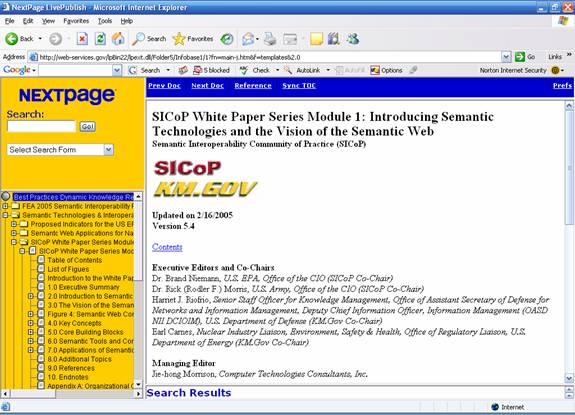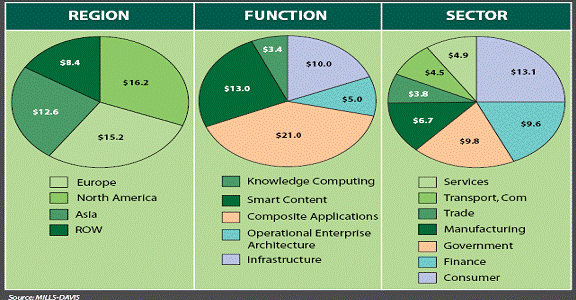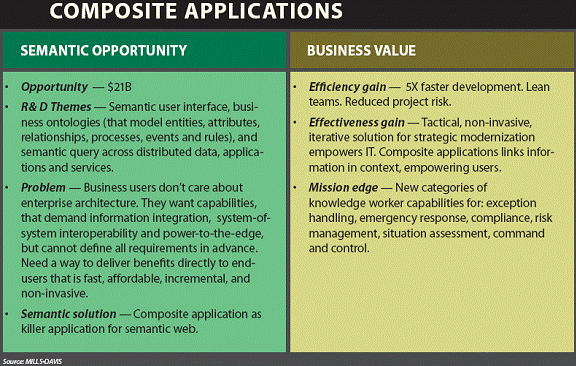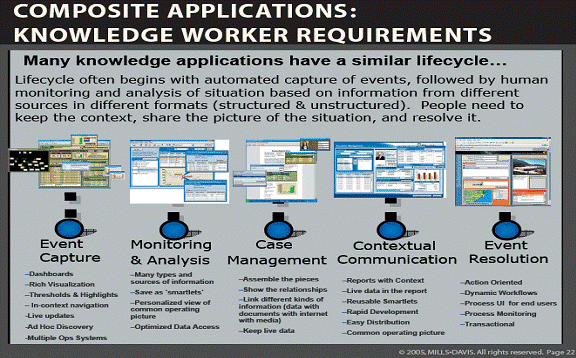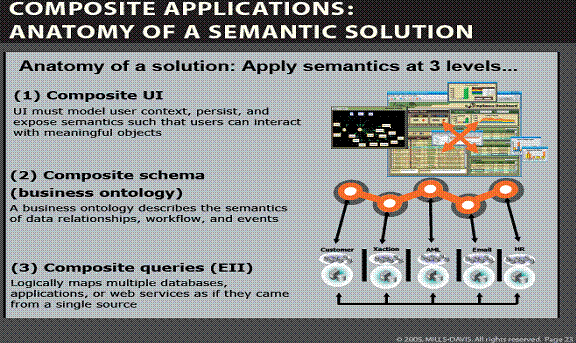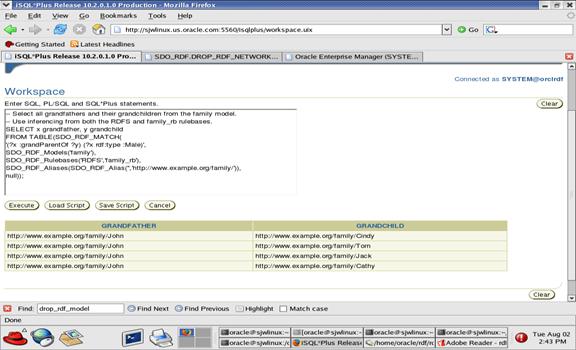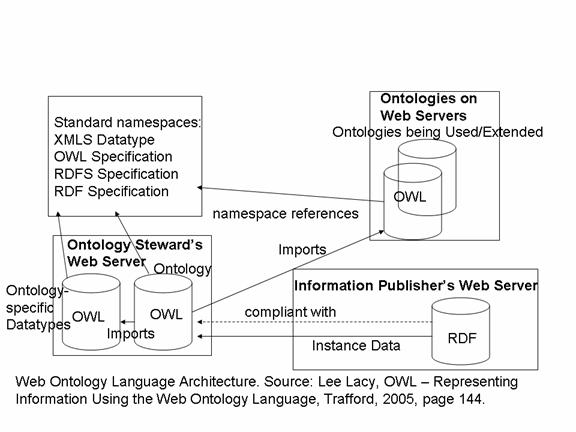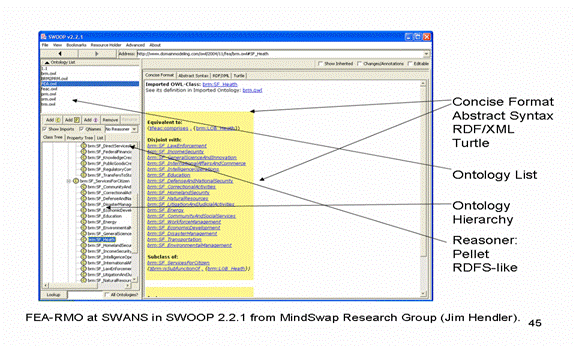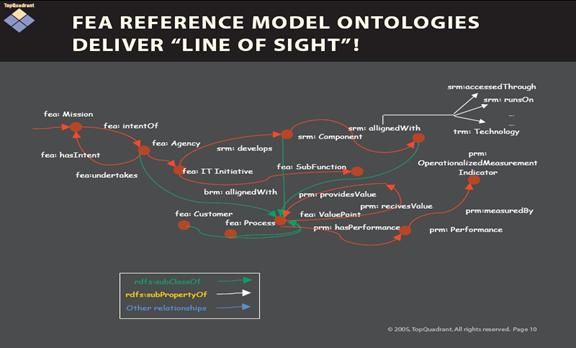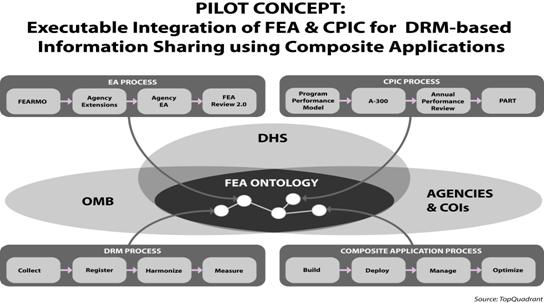The Federal CIO Council’s Semantic Interoperability Community of Practice (SICoP)
Keywords: DAML, E-Government, Interoperability, RDF, Ontology, Semantic Web
Abstract
The Semantic Interoperability Community of Practice (SICoP) has made considerable progress towards implementations of semantic technologies and web standards in the U.S. government with a series of white papers, conferences, and pilot projects. The goal is to create executable enterprise models in composite applications for E-Government.
This paper is organized into the following sections: 1. Background, 2. Conferences and Public Meetings, 3. White Papers, 4. Working Groups and Pilot Projects, 5. Deploying RDF and OWL, 6. Conclusions and Next Steps, and Acknowledgements.
Table of Contents
1. Background
This section provides the SICoP Charter Excerpts, XML 2004 Contributions, including what was promised at XML 2004 and what was delivered in 2005 so far, and an Overview of the Paper.
1.1. Charter Excerpts
The Semantic Interoperability Community of Practice (SICoP) is established by a group of individuals for the purpose of achieving "semantic interoperability" and "semantic data integration" in the government sector.
The SICoP seeks to enable Semantic Interoperability, specifically the "operationalizing" of these technologies and approaches, through online conversation, meetings, tutorials, conferences, pilot projects, and other activities aimed at developing and disseminating best practices.
The individuals making up this CoP represent a broad range of government organizations and the industry and academic partners that support them. However, the SICoP claims neither formal nor implied endorsements by the organizations represented.
1.2. XML 2004 Contributions
SICoP contributed both a presentation and organized a Town Hall at the XML 2004 Conference as follows:
XML 2004 Presentation: The Federal CIO Council's Semantic Interoperability Community of Practice (SICoP) [http://www.idealliance.org/proceedings/xml04/abstracts/paper224.html]
XML 2004 Town Hall: Networking of U.S. Federal Government Communities of Practice Using XML [http://www.idealliance.org/proceedings/xml04/abstracts/paper319.html]
|
Future Activities: Promised in 2004 |
Future Activities: Delivered in 2005 |
|
The E-Gov Act of 2002. |
Merged with DRM below. |
|
The Federal Enterprise Architecture’s Data Reference Model (DRM). |
Yes! |
|
Selected Lines of Business (e.g., Data & Statistics and Federal Health Architecture). |
Yes! |
|
Individual E-Gov Initiatives and Agency Missions. |
US EPA! |
|
White Paper Modules 2 and 3. |
Yes! |
|
Coordination and participation in the W3Cs Semantic Web Best Practices and Deployment Working Group. |
Somewhat. |
|
Plan for the Third Semantic Technologies for eGovernment Conference! |
Yes – SICoP Public Meeting, September 14, 2005, and Announced for March 23-24, 2006. |
Table 1. SICoP Promises in 2004 and Deliveries in 2005
1.3. Overview of the Paper
Section 2. Conferences and Public Meetings
Section 3. White Papers
Section 4. Working Groups and Pilot Projects
Section 5. Deploying RDF and OWL:
Note: To be used for the Tuesday, November 15th, 11 a.m. Session: The PCs PI Guide to Deploying XML.
Section 6. Conclusions and Next Steps
Acknowledgements
2. Conferences and Public Meetings
This section summarizes the SICoP conferences and public meetings, the recent SICoP Special Recognitions, and the SICoP use of Dynamic Knowledge Repository - Best Practices and Dynamic Knowledge Repository - Community Wiki.
The Public Meetings and Conferences were:
(1) First Annual Semantic Technologies for e-Government Conference, September 8, 2003: Eric Miller and Jim Hendler keynoted, Semantic Web book distributed, over 100 attended, and 10 vendors exhibited. See Proceedings [http://www.topquadrant.com/conferences/tq_proceedings.htm] and Dynamic Knowledge Repository [http://www.sdi.gov/lpBin22/lpext.dll/Folder6/Infobase3/1?fn=main-j.htm&f=templates&2.0].
(2) Second Annual Semantic Technologies for e-Government Conference, September 8-9, 2004: Eric Miller and Jim Hendler keynoted, over 250 attended, and 30 vendors/posters exhibited. See Proceedings [http://www.topquadrant.com/conferences/sept8_2004/stgov04_proceedings.htm].
(3) Semantic Web Applications for National Security (SWANS) Conference, April 7-8, 2005: Joint DARPA/DAML and SICoP effort, Sir Tim Berners-Lee keynoted, over 320 attended, and 40 vendors/posters exhibited. See Proceedings [https://www.schafertmd.com/swans/] and Dynamic Knowledge Repository [http://web-services.gov/lpBin22/lpext.dll/Folder5/Infobase4/1?fn=main-j.htm&f=templates&2.0].
(4) Semantic Interoperability Community of Practice (SICoP) Public Meeting, September 14, 2005: White Papers 2 and 3 presented and four Special Recognitions for Best Practices. See Wiki [http://colab.cim3.net/cgi-bin/wiki.pl?SICoPConference_2005_09_14].
The four SICoP Special Recognitions were given to Mills Davis, Roy Roebuck, Rohit Agarwal, and Peter Yim and Mark Musen at the SICoP Public Meeting on September 14, 2005. See slides 23-26 [http://web-services.gov/sicop09142005.ppt] for the specifics of these SICoP Special Recognitions.
The SICoP Dynamic Knowledge Repository - Community Wiki is shown in Figure 1 below.
Note the this Wiki is “Purple Number [http://colab.cim3.net/cgi-bin/wiki.pl?PurpleNumbers]” and RSS enabled!
The SICoP Dynamic Knowledge Repository - Best Practices is shown in Figure 2 below.
SICoP is trying to integrate Engelbart’s Open Hyperdocument System and the W3C’s Semantic Web paradigms in its use of tools. See Facilitating the Evolution of Our Collective IQ by Doug Engelbart [http://colab.cim3.net/cgi-bin/wiki.pl?ExpeditionWorkshop], September 1, 2005.
3. White Papers
SICoP has three White Papers as follows:
(1) Introducing Semantic Technologies and the Vision of the Semantic Web [http://colab.cim3.net/file/work/SICoP/WhitePaper/SICoP.WhitePaper.Module1.v5.4.kf.021605.doc]: Delivered to the CIO Council's Architecture & Infrastructure and Best Practices Committees, February 16, 2005, and Being Translated into Japanese. (Recall Figure 2).
(2) The Business Case for Semantic Technologies [http://colab.cim3.net/file/work/SICoP/2005-09-14/BizValue050914.pdf]: For public discussion on September 14, 2005.
(3) Implementing the Semantic Web: Roadmap, Resources, and Featured Best Practice Implementation Example [http://colab.cim3.net/cgi-bin/wiki.pl?SICoPConference_2005_09_14] for public discussions on September 14, 2005.
The Business Case for Semantic Technologies White Paper Team is lead by Mills Davis, Project10X’s managing director for industry research and strategic programs. Mills Davis consults with technology manufacturers, global 2000 corporations, and government agencies on next-wave semantic technologies. A noted researcher and industry analyst, Mills has authored more than 100 reports, whitepapers, articles, and industry studies.
The Business Case for Semantic Technologies White Paper contains the following topics:
Quick facts, Semantic technologies, Technology providers, Early adoption, and Business Value Opportunity;
and the following Semantic execution value paradigms:
Operational enterprise architecture, Composite applications, Smart content, and Knowledge computing.
The principal conclusions are:
(1) SEMANTIC TECHNOLOGIES ARE ABOUT PUTTING ONTOLOGIES TO WORK...:
SEMANTIC MODELS (AKA ONTOLOGIES) ARE LIKE AND UNLIKE OTHER IT MODELS:
Like XML schemas they are native to the web (and are in fact serialized in XML). Unlike XML schemas, ontologies are graphs not trees, and used for reasoning.
(2) NEARLY 200 SEMANTIC TECHNOLOGY R& D, PRODUCT & SOLUTION PROVIDERS.
(3) MORE THAN 100 SEMANTIC TECHNOLOGY EARLY ADOPTER BUSINESS CASES.
(4) BUSINESS PERFORMANCE IMPROVES 2-10X.
(5) SEMANTIC EXECUTION WORLD-WIDE MARKET WILL EXCEED TO $50 BILLION BY 2010 (see Figure 3 below).
Because of the importance to both the Business Case for Semantic Technologies and Implementing the Semantic Web, Composite Applications are described in more detail in this section as follows:
(1) The Semantic Opportunity and Business Value:
(2) Knowledge Worker Requirements:
(3) The Anatomy of a Semantic Solution:
Composite Applications have the following implications for the Federal Enterprise Architecture Data Reference Model [http://colab.cim3.net/cgi-bin/wiki.pl?DataReferenceModel]:
(1) Tools that enable exchange, compositing and harmonization of distributed data and metadata sources in the context of the intended end-use application.
(2) Sharing semantic models for composite applications that include entities, attributes, relationships, processes, events, and rules as well as security and provenance.
A Summary of the Business Case for Semantic Technologies White Paper to date is as follows:
(1) Semantic technologies are about putting ontologies (semantic models) to work.
(2) Nearly 200 firms have semantic products and solution development underway. Nearly 100 have products.
(3) SICoP research has reviewed more than 100 government and industry business cases.
(4) Early adopter research documents 2 to 10 times improvements in key measures of performance across the solution lifecycle.
(5) Semantic solution, services & software markets will top $50B by 2010.
(6) Four semantic execution value paradigms will drive adoption: operational enterprise architecture, composite applications, smart content, & knowledge computing.
A Summary of the Implementing the Semantic Web White Paper to date is as follows:
(1) A Roadmap [http://colab.cim3.net/cgi-bin/wiki.pl?ExpeditionWorkshop/DesigningTheDRM_DataAccessibility_2005_08_16#nid2UHU] (see basic steps below) has been outlined for working “locally and globally” multiple Communities of Interest in our Collaborative Workshops.
(2) A Compilation of Resources [http://colab.cim3.net/cgi-bin/wiki.pl?SICoPConference_2005_09_14#nid2YFB] has been provided for hands on work in the Collaborative Workshops and afterwards.
(3) A Featured Best Practice Implementation Example has been provided: Modeling Data and Processes for 360 Degree Views [http://colab.cim3.net/file/work/SICoP/2005-09-14/DHGovernment.ppt], Rohit Agarwal, Digital Harbor. Recall Figures 4-6. See Executable Integration of the FEA Reference Models in Composite Applications Fact Sheet [http://web-services.gov/SICoPPilotFactSheet_Final.pdf] and live demos for the Intelligence Community [http://web-services.gov/pilots/DigitalHarbor/terrorismdemo.htm], Voting/Census Data [http://web-services.gov/pilots/DigitalHarbor/CampaignFinance.htm], Water Resources (in process), and FEA Management (in process).
The Basic Steps in the Roadmap are as follows:
(1) Learn About the W3C’s Standard for Data Modeling and Information Sharing (RDF): The Semantic Interoperability Information Sharing Tool Kit Pilot Part 2 - Modeling and Merging of Vocabularies.
(2) Learn to Use Tools to View, Create, and Validate RDF.
(3) Learn About a Major New Semantic Web Application Called DOAP: Description of a Project from a Tutorial.
(4) Learn About the Semantic Technology Profiles for the Federal Enterprise Architecture Data Reference Model (DRM).
4. Working Groups and Pilot Projects
This section summaries the SICoP Working Groups/Teams and Pilot Projects as follows:
(1) Common Upper Ontology WG ("CUO-WG") [http://colab.cim3.net/cgi-bin/wiki.pl?CommonUpperOntologyWG]: Lead - Jim Schoening, U.S. Army.
(2) FEA Reference Model Ontology [http://colab.cim3.net/file/work/SICoP/project/fea-rmo/fea-rmo.html] (See Section 5): Lead - Rick Murphy, GSA, Submit Comments [http://colab.cim3.net/cgi-bin/wiki.pl?HowToSubmitFEARMO_Comments].
(3) Ontology Taxonomy Coordination WG ("ONTAC") [http://colab.cim3.net/cgi-bin/wiki.pl?OntologyTaxonomyCoordinationWG]: Lead - Pat Cassidy, MITRE.
(4) DRM Implementation Through Iteration and Testing Pilot Projects [http://colab.cim3.net/cgi-bin/wiki.pl?DRMImplementationThroughIterationandTestingPilotProjects]: Lead – Brand Niemann, SICoP Chair.
Pilot Projects Brief History:
(1) 2003 - 8 vendors
(2) 2004 - 20 vendors
(3) SWANS 2005 - 40 vendors
(4) Today’s Module 2 database - over 150 vendors!
(5) 28 presented at Workshops [http://colab.cim3.net/cgi-bin/wiki.pl?ExpeditionWorkshop#nid2RG3]/Forums [http://colab.cim3.net/cgi-bin/wiki.pl?DataReferenceModelPublicForum_2005_06_13] in the last 3 months!
5. Deploying RDF and OWL
The purpose of this section is to provide a brief tutorial on deploying RDF and OWL that is coordinated with the following two XML 2005 Conference Program items:
(1) Tuesday, November 15th, 11 a.m., The PCs PI Guide to Deploying XML.
(a) Sources: Shelley Powers, Practical RDF, Solving Problems with the Resource Description Framework [http://www.oreilly.com/catalog/pracrdf/], O’Reilly, 2003.
(b) Thomas Passin, Explorer’s Guide to the Semantic Web [http://www.manning.com/books/passin], Manning Publications, 2004.
(c) Lee Lacy, OWL – Representing Information Using the Web Ontology Language [http://www.trafford.com/4dcgi/robots/04-1276.html], Trafford, 2005.
(2) Friday, November 18th, 9 a.m. – 5:30 p.m., Shelley Powers, Tutorial: Pushing Triples: An Introduction to Street RDF [http://2005.xmlconference.org/tutorials/fridayfull#4].
The highlights of the tutorial are as follows:
(1) Ever since I started working with XML in its earliest days, I’ve longed for a metamodel to define vocabularies in XML that could be merged with other vocabularies, all of which could be manipulated by the same APIs. I found this with RDF and RDF/XML (Shelley Powers).
(2) If RDF is analogous to the relational data model, and RDF/XML is analogous to relational database systems, then OWL is equivalent to applications such as SAP and PeopleSoft which implement a business domain model on top of the relational store.
(3) Differences between RDF/XML and XML:
(a) RDF/XML uses namespace and URIs (URLs in this case).
(b) RDF/XML is more difficult to read and to see the relationships between the data – a common complaint about RDF/XML.
(c) RDF/XML adds a layer of complexity on the XML that can be off-putting when working with it manually.
(d) Within an automated process, though, the RDF/XML structure is actually an advantage:
There is a fairly significant strain on memory use, particularly with processing larger XML documents.
Optimized query capability and joining vocabularies are excellent reasons for using RDF as a model for data and RDF/XML as a format.
(4) When to Use and Not Use RDF:
(a) RDF/XML meets a business rather than a technical need to use the model and related XML structure.
(b) RDF/XML is not a replacement for XHTML, CSS, SOAP, & XML-RPC.
(5) Model for RDF:
(a) A collection of statements (or triples), each with a subject, predicate, and an object (English grammar).
(b) RDF Formats:
XML
Graphs
Non-XML (Notation 3-N3 and N-triples):
<#sedan> <is a type of> <#automobile> (see next slide)
Tim Berners-Lee and Dan Connolly, unofficial, but published in document by the W3C [http://www.w3.org/2000/10/swap/doc/cwm.html].
N3 processors like, cwm, can perform logical inferences on the triples and N3 can be converted into RDF/XML and vice versa.
See “Explorer’s Guide to the Semantic Web [http://www.manning.com/books/passin],” Thomas Passin, Manning Publications, 2004, Chapter 2. Describing data with RDF, page 56.
(6) RDF can be stored and used in inferencing in new tools like Oracle 10g R2:
Source: 39. Grandfathers – With Inferencing [http://web-services.gov/scope08162005a.ppt]
(7) Semantic Web’s Layered Architecture Definitions:
(a) RDF and RDF/XML: RDF is the model and RDF/XML is the XML syntax for storing the model. RDF is used to specify OWL instances. It is the most important value-added layer of the Semantic Web’s architecture.
(b) RDF Schema (RDFS): RDF’s vocabulary description language, is the a semantic extension of RDF. It provides the mechanisms for describing groups of related resources and the relationships between these resources.
(c) OWL permits the definition of sophisticated ontologies, a fundamental requirement in the integration of heterogeneous information content. OWL ontologies will also be important for the characterization of interoperable services for knowledge-intensive processing on the Web (e.g., Grid and Pervasive Computing).
Source: Lee Lacy, OWL – Representing Information Using the Web Ontology Language [http://www.trafford.com/4dcgi/robots/04-1276.html], Trafford, 2005, pages 83, 111 , and 133.
(8) Sir Tim Berners-Lee on criticisms of the Semantic Web:
(a) One of the criticisms I hear most often is, “The Semantic Web doesn’t do anything for me I can’t do with XML”. This is a typical response of someone who is very used to programming things in XML, and never has tried to integrate things across large expanses of an organization, at short notice, with no further programming. One IT professional who made that comment around four years ago, said a year ago words to the effect, “After spending three years organizing my XML until I had a heap of home-made programs to keep track of the relationships between different schemas, I suddenly realized why RDF had been designed. Now I use RDF and its all so simple – but if I hadn’t have had three years of XML hell, I wouldn’t ever have understood.”
(b) Many of the criticisms of the Semantic Web seems (to me at least) the result of not having understood the philosophy of how it works. A critical part, perhaps not obvious from the specs, is the way different communities of practice develop independently, bottom up, and then can connect link by link, like patches sewn together at the edges. So some criticize the Semantic Web for being an (clearly impossible) attempt to make a complete top down ontology of everything.
Source: June 2005 Interview by Andrew Updegrove [http://www.consortiuminfo.org/bulletins/pdf/jun05/feature.pdf].
(9) Sir Tim Berners-Lee at the SWANS Conference [https://www.schafertmd.com/swans/], April 7 on “the constant tension” between working locally and globally (seeTable 2, “Sir Tim Berners-Lee at the SWANS Conference, April 7 on “the constant tension” between working locally and globally” below):
(a) Keep a wise balance.
(b) The semantic web allows a mixture of the two approaches, and smooth transitions between them.
|
Work locally |
Work in wider group |
|
Fast: Just do it |
Slow: Committees! |
|
Concepts match local needs |
Have to adapt to other group's concepts |
|
Less usable later |
Later, serendipitous reuse |
|
Start locally |
Later negotiate |
Table 2. Sir Tim Berners-Lee at the SWANS Conference, April 7 on “the constant tension” between working locally and globally
(10) Resources for Creating, Viewing and Validating RDF [http://colab.cim3.net/cgi-bin/wiki.pl?ExpeditionWorkshop/ResourcesAndToolsForWorkshop43_2005_08_16]
|
Type |
Purpose |
Example |
URL |
|
Unstructured |
Categorization & Search Enhancement |
DCDOT |
http://www.ukoln.ac.uk/metadata/dcdot/ http://www.w3.org/RDF/Validator/ |
|
Semi-structured |
Sharing |
FOAF |
http://www.ldodds.com/foaf/foaf-a-matic.html http://rdf.burningbird.net/ |
|
Structured |
Integration |
ConvertToRDF |
http://www.mindswap.org/~mhgrove/ConvertToRDF/ Oracle 10gR2 |
Table 3. Resources for RDF
(11) Encoding an OWL Ontology:
(a) Phases:
Object-oriented requirements analysis: Develop common expectations for the domain description.
Knowledge acquisition: Use authoritative sources for the domain.
Knowledge engineering: Describe a structured interpretation of the domain that references the authoritative sources.
Design: Use graphical design languages like UML to visualize the relationships.
(12) OWL Ontology File Structure:
(a) OWL Header (usually reused):
XML Declaration and RDF Start Tag
Namespaces
Versioning Information and Import Statements
Ontology Element (owl:Ontology)
(b) Body:
Statements about classes, properties, and their relationships.
Makes the open-world assumption – just because something is not specified, you cannot assume it to be false; it might be specified somewhere on the web.
(c) Footer – Closing Tag.
(d) Example: An organization standardizes their ontologies that extend another organization’s ontologies (see Figure 8 below).
Source: Lee Lacy, OWL – Representing Information Using the Web Ontology Language [http://www.trafford.com/4dcgi/robots/04-1276.html], Trafford, 2005, Chapter 11.
(13) Modeling the FEA Reference Model Documents
(a) Federal Enterprise Reference Model Ontology (FEA RMO):
This is a composite application with multiple ontologies created from manually extracting the concepts from the FEA PRM, BRM, SRM, and TRM documents into Protégé.
This has been recommended to OMB/AIC as the way to maintain and update the Reference Models in the future to insure semantic consistency across all the Reference Models (and Profiles).
(b) Online Version:
Home Pages: http://colab.cim3.net/file/work/SICoP/project/fea-rmo/fea-rmo.html and
http://www.osera.gov [http://www.osera.gov/]
Documentation: Best Practices Repository at http://web-services.gov [http://web-services.gov/]
Submit FEARMO comments: http://colab.cim3.net/cgi-bin/wiki.pl?HowToSubmitFEARMO_Comments
(14) The FEA Reference Model Ontology in SWOOP 2.1.1 [http://www.mindswap.org/2004/SWOOP/]
(15) FEA Reference Model Ontologies Deliver “Line of Sight”!
(16) Pilot Progress to be reported by Mills Davis at the Joint CoP Meeting at the Enterprise Architecture Conference [http://colab.cim3.net/cgi-bin/wiki.pl?EAConferenceJointCoPMeeting], September 21, 2005, noon-2 p.m., Ronald Reagan Building and International Trade Center, Hemisphere A, Washington, DC.
Conclusion of the tutorial.
The next phase of deploying RDF and OWL in the Federal Government is being developed as part of the Data Reference Model Implementation Through Iteration and Testing [http://colab.cim3.net/cgi-bin/wiki.pl?DRMImplementationThroughIterationandTestingPilotProjects] work and will be reported at the March 23-24, 2006, SICoP [http://colab.cim3.net/cgi-bin/wiki.pl?SICoP] Public Meeting/Fourth Semantic Technologies for E-Government Conference.
A. 6 Conclusions and Next Steps
This section summaries the SICoP Goals for 2006 and some Upcoming Events to accomplish those goals:
SICoP Goals:
(1) Conduct Regular Collaboration Workshops and Conference Calls.
(2) Make Public Data Available in Standard Semantic Web Formats* and Build Ontologies. (*Suggested by Sir Tim-Berners Lee at the SWANS Conference, April 7, 2005.
(3) Complete White Paper 3. Implementing the Semantic Web.
(4) Complete the Federal Enterprise Architecture Data Reference Model Implementation Through Iteration and Testing Work.
SICoP Upcoming Events:
(1) National Center for Ontological Research (NCOR) [http://ncor.us/], Inaugural Event, October 27-28, 2005: Towards e-Government: The Federal Enterprise Architecture Reference Ontology (with Peter Yim, Co-Convenor, Ontolog Forum).
(2) SICoP Public Meeting/Fourth Semantic Technologies for E-Government Conference, March 23-24, 2006, MITRE: Day 1 for Vendor/Poster Displays and Tutorials. Day 2 for Presentations/Demonstrations/Discussions (like the SWANS 2005 Conference).
Acknowledgements
Biography
Dr. Niemann has been with the U.S. EPA for 25 years and currently works in the Office of the Chief Information Officer and Assistant Administrator for Environmental Information as an Enterprise Architect and Semantic Web Services Specialist and Chairs the Federal CIO Council’s Semantic Interoperability Community of Practice (SICoP). Also see XML 2005 Program Committee [http://2005.xmlconference.org/about/pc#niemann], SICoP Web Page [http://web-services.gov/], and SICoP Wiki Page [http://colab.cim3.net/cgi-bin/wiki.pl?SICoP].
